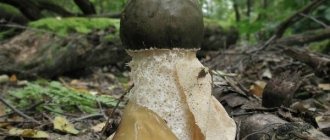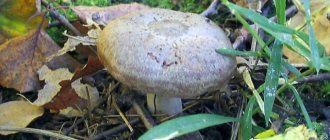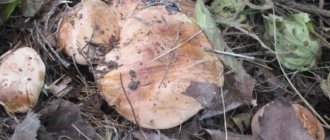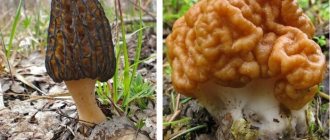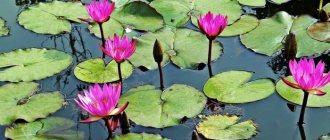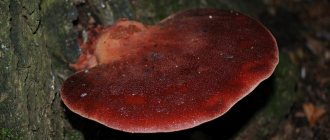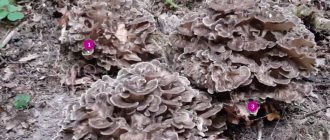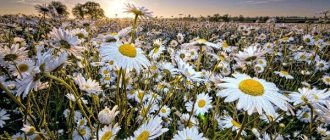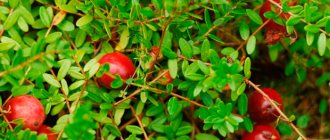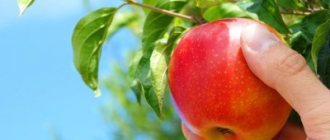General information about bruise mushrooms
Gyroporus blue is a tubular cap mushroom from the genus Gyroporus of the Gyroporaceae family. Oaks belong to the genus Boletus of the Boletaceae family. All these mushrooms are edible, and under the general name “bruise” they are united by the fact that their flesh turns blue when broken or cut.
Contraindications
It is possible to confuse an edible mushroom with a poisonous one. Mushrooms with caustic flesh are inedible and often toxic. When eaten, there is a possibility of damaging the mucous membrane, which will lead to nausea and vomiting.
Russulas are contraindicated for people suffering from ulcers or heart disease: they are difficult to digest. They should not be eaten in large quantities even by people who do not have health problems. The dosage should be less than 150 g at a time.
They are allowed to be eaten only after reaching 7 years of age.
Characteristics of a bruise
hat
— Advertising —
The diameter of the cap is 5-20 cm, the shape changes with age from convex to flat. Colored in various shades from whitish to yellow or brown. The surface is usually velvety and darkens when pressed.
Pulp
The pulp is dense, thick, light, when broken it acquires a characteristic blue color, the taste and smell are weakly expressed.
Leg
— Advertising —
The leg is about 15 cm in height, and up to 5 cm in thickness, of various shapes. The color matches the cap. In some species it is covered with a mesh pattern.
Beneficial features
Sinyavka, or russula, is a low-calorie mushroom (19 kcal per 100 g), but at the same time it has good nutritional properties. Due to its low calorie content and high chitin content, it is recommended to eat it to cleanse the intestines.
Mushrooms have antibacterial properties
The flesh of the mushroom is brittle, so it is difficult to bring it to its destination in its entirety. Bruises contain a substance called russulin, which helps dairy products curdle. This function is in demand for creating cheeses.
Also, the cells of the fungus contain lecithin, which helps avoid cholesterol deposits in the body. Thanks to this substance and low calorie content, russula helps in the fight against excess weight.
Representatives of the genus are also used to combat gastrointestinal diseases, prevent blood clots, as an antibacterial agent, and to supply the body with vitamins PP and B2.
Types of mushroom
Gyroporus cyanescens
The diameter of the mushroom cap is 5-15 cm, the shape is from convex to flat, the color is straw-yellow, brown-yellow or grayish-brown, and turns blue when touched. The surface of the cap is matte, velvety, and dry to the touch. The pulp is brittle, white or cream in color, and turns bright cornflower blue when cut. It has a pleasant taste and aroma. The stem is 5-10 cm long, 1.5-3 cm thick, thickens towards the base, the inside of young mushrooms is filled with cotton wool, later becomes hollow or with voids, the color is white or matches the color of the cap.
Grows in deciduous and mixed forests, often next to birches, chestnuts and oaks, on sandy soils. The mushroom is found in the northern temperate zone. Listed in the Red Book of Russia as a rare species. Fruiting season is July-September.
An edible mushroom, without a bitter aftertaste, unlike chestnut gyroporus. Often used for drying and in making sauces.
Olive brown oak (Boletus luridus)
The cap is 5-20 cm in diameter, hemispherical or convex in shape, and with age can open up to a flat one. The surface is olive-brown, velvety, and becomes slimy in humid weather. When touched it becomes covered with dark spots. The pulp is yellowish in color, dense, red at the base of the stem, at the break it acquires a characteristic blue color, and later becomes brown. It has a mild taste and no pronounced odor. The leg is 6-15 cm high, 3-6 cm thick, club-shaped with a tuberous thickening, yellow-orange in color, red-brown at the base, covered with a convex brownish-red mesh pattern with long loops.
Grows next to oaks, beeches, birches, on calcareous soils, in bright, warm places, both in deciduous and mixed forests. This is a heat-loving mushroom that grows in Europe, the Caucasus, Western Siberia, and the Far East. The growing season lasts from July to September, with mass fruiting observed in August.
A conditionally edible mushroom that requires preliminary heat treatment (it is boiled and drained). It is used for food in pickled form. After adding citric acid, the blue oak pulp again acquires a yellowish color. The mushroom is also dried.
Raw or undercooked mushrooms cause gastrointestinal disorders. Not recommended for use with alcohol.
Speckled Oak (Boletus erythropus)
The cap is 5-20 cm in diameter, hemispherical, cushion-shaped, rounded-cushion-shaped, the surface is velvety, matte, sometimes slimy, and becomes bare as the mushroom matures. The color of the cap is varied, from chestnut brown, dark brown, dark brown, black-brown to olive or reddish, darkening when touched. The pulp is yellowish or bright yellow, turns blue or blue-green at the break, and reddish or brownish at the stem. Taste and smell are not expressed. The stem is 5-15 cm long, 1.5-4 cm thick, cylindrical or tuberous in shape, sometimes barrel-shaped, in mature mushrooms thickened downwards, the surface is yellow-red, without a reticulate pattern, covered with red scales.
Grows in deciduous and coniferous forests, under beech, oak, spruce, fir, on acidic soils, found in swampy areas, in mosses. The species grows in Europe, the Caucasus, Siberia, and the Far East. It bears fruit from mid-May to October, and is found in large numbers in July.
A conditionally edible mushroom, used in cooking only after boiling for 15 minutes, also used for drying. Sauces and side dishes for meat dishes are prepared based on the mushroom.
Application
Blue mushrooms are widely used both in cooking and in the creation of medicinal preparations.
In cooking
To prevent the beneficial components from being destroyed under the influence of high temperatures, you can simply pour boiling water over the mushrooms, add salt, and leave to brew for 15 minutes. Only after that do they perform any actions with them.
The decoction of russula is used to make soup.
Irina Selyutina (Biologist):
Types of russula, the pulp of which does not have a pungent taste, are usually used for cooking. Species with pungent pulp are usually used for pickling. Before this, any russula is soaked or boiled. For russula, the hot salting method is considered preferable - first boiling for about 30 minutes and only then the actual salting. At the same time, the russula is laid out in jars, sprinkled with salt with the obligatory addition of garlic, allspice, dill, and blackcurrant leaf. Otherwise there will simply be no taste - they simply don’t have it.
Did you know? Russulas easily release salt when soaked. Therefore, even heavily salted mushrooms can be kept in water for 1 hour and can be used for their intended purpose: frying, cooking soup. They taste almost no different from fresh mushrooms.
In medicine
The content of medicinal components in these mushrooms is small. At the same time, russula is used for the prevention and cleansing of the gastrointestinal tract (in particular the intestines), accelerating metabolism, blood vessels, lowering cholesterol and blood sugar.
Russulas are taken as food to thin the blood and as a preventive measure for vein thrombosis. The decoction is used to relieve signs of poisoning, diarrhea, and also as a diuretic. An infusion of dried russula is recommended for sclerosis and heart problems. Compresses made from mushroom pulp help eliminate abscesses.
Raw mushroom pulp is used to remove corns and dead skin particles. Mushroom juice can rejuvenate, reduce the severity of pigmentation, and make the skin soft and elastic.
Poisonous and inedible types of mushroom
Kele's Oak (Boletus queletii)
Poisonous mushroom.
The cap is up to 15 cm in diameter, round or convex in shape. The surface is chestnut-brown in color, velvety in young mushrooms, smooth and dry in mature ones, the skin cannot be removed. The pulp is fleshy, dense, yellowish in color, brown in the stem, and turns blue when cut. The leg is 4-15 cm high, 1-3.5 cm thick, cylindrical in shape, thickened towards the base, solid. There is no pattern or scales on the surface, the color is yellow-brown.
A rare species, grows in deciduous forests of Russia, the Caucasus, and the Far East. Fruiting season May-October
Satanic mushroom (Boletus satanas)
Poisonous mushroom.
The diameter of the cap is 8-25 cm, the shape is hemispherical, rounded-cushion-shaped, in mature mushrooms it becomes prostrate, the surface is smooth or velvety, dry, painted white, grayish, green-gray, rarely with a yellow tint. The pulp is white or yellowish, red in the stem, slightly blue or red when cut, reddish in the stem. Mature mushrooms have an unpleasant odor. The stem is 5-15 cm in height and 3-10 cm in thickness, in young mushrooms it is ovoid or spherical in shape, later it becomes tuberous, barrel-shaped or turnip-shaped, narrows towards the top, dense, colored yellowish-red on top, bright red in the middle, brownish-yellow at the base. Covered with a mesh pattern.
Grows in deciduous forests, under oaks, beeches, hornbeams, hazels, chestnuts, lindens, and on calcareous soils. It is found in southern Europe, Russia, the Caucasus, the Middle East, and the Primorsky Territory. The growing season lasts from June to September.
What can be confused with “bluelegs”?
Of course, this is difficult to do, this representative is very bright. But there are still similar ones and you need to know how to distinguish them:
- Violet row is a conditionally edible mushroom. Its only difference is its bright purple hat. And if the blue leg has a slightly purple color, then here the shade will be more saturated;
- The weed row is also very similar, but much smaller in size;
- Purple cobweb is conditionally edible and can also be put in the basket. But the taste will be slightly different. You can distinguish it by the “blanket” located under the cap and color. Its upper part is grayer, with an ashy coating;
- The white-purple cobweb is a poisonous mushroom, you need to be extremely careful with it. It looks a little like a “blue root”, but its flesh is light yellow, which is noticeable if you break it. Sometimes there are purple spots in it. If the weather is calm, you may also notice a strong odor.
Growing mushrooms at home
Mushroom mycelium is planted at any time of the year, under deciduous or coniferous trees.
Powdered mushroom mycelium is mixed with dry soil or sand.
The soil is fluffed up in the area and depressions of 5-15 cm are made. The mycelium mixture is evenly scattered over the surface of the area and covered with garden or forest soil, in an equal mixture with humus. The area is watered with water (10 liters per 1 m2), and the top is sprinkled with earth again. In the dry season, the area is watered at the rate of 15-20 liters per 1m2, often.
Mushrooms are harvested twice in spring and twice in autumn.
While mushrooms do not grow in the area, it is fertilized with humus.
Where do bluelegs grow?
Blueleg is predominantly a southern mushroom. But in general it is found throughout Russia, including in the Moscow region.
It can be found most often in meadows or pastures. They grow in colonies, so when you see them, you can’t go wrong. You will come across small “islands” in the form of a circle or “path”.
And sometimes you can see them very close. Podavniki love soils rich in organic matter. Therefore, they often appear near farms, houses and even in compost ditches.
In the forest, on the contrary, you will rarely see this species; they prefer well-lit spaces. But, if there are several colonies in the thicket, then under deciduous trees.
